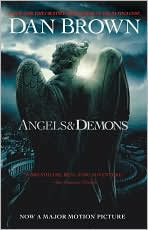The Rome of Angels and Demons
The sights in Rome featured in the Dan Brown novel (and Tom Hanks movie) Angels & Demons
One thing all you Dan Brown fans should know:
Bernini's art does not comprise some kind of giant, Roman-spanning baroque geocaching map of clues to a dark and dangerous secret.
Also, the author took several literary licenses with history (and even placement of churches around the city) in order to get his thrilling plot to tick just right.
What's more, the Vatican was (unsurprisingly) excessivley un-cooperative when the movie came to Rome to film, so none of the church interiors in which you see Tom Hanks scurrying around on the big screen are real. They're all sets based on the actual churches.
SPOILER ALERT
Actually, I fully intend not to reveal anything important about the plot. I'm just going to present the sites themselves below, without mentioning anything about their role in the
book or
movie.
If you read it or saw it, you'll know (well, if you only saw the
movie, you might be confused by the inclusion of a few spots here since the
book visits more places in Rome than the
film did). I might later create a fans-only page that details each sights role in the plot.
Still, for many people,
Angels & Demons was their first introduction to some of Rome's excellent, slightly less famous sights, like the churches of
Santa Maria del Popolo and
Santa Maria della Vittoria.
For you fans, I provide the following cheat sheet to help you find all the major sights in featured in the book and movie.
Or, you might prefer simply to take an Angels & Demons–themed tour of Rome.
Angels & Demons sights in Rome
The capital of Christendom and most magnificent basilica on Earth is a late-Renaissance/early-baroque masterpiece of architecture and decoration, an artistic collaborations across the centuries between the likes of
Michelangelo and
Bernini, and something of a personal pulpit for the man who lives next door: the Pope...
» more
The current pope's personal quarters and other functioning Vatican offices are, of course, off-limits to the casual tourist. However, you can stroll around several frescoed and art-bedecked
apartments belonging to past popes, including the fabulous
Raphael Rooms (used by popes Julius II and Leo X),
Nicholas V's private chapel (frescoed by Fra' Angelico), and Alexander VI's
Borgia Apartments (frescoed by Pinturicchio)...
» more
The iconic fingers-almost-touching detail of Michelangelo's
God creating Adam takes up merely a few square inches of ceiling in a chapel 132 feet long by 46 feet wide by 70 feet tall nearly every inch of which is swathed in some of the greatest frescoes of the Renaissance...
» more
The only ancient Roman temple to survive the millennia intact is also one of the most amazing architectural spaces in Rome, an expansive cylinder swaddled in precious marbles, topped by a vast concrete hemisphere, and pierced by a wide shaft of sunlight from the oculus at the center...
» more
This little gem of a church at the very northern edge of the city center is one of my favorite in all of Rome, and it acts as a primer of Italy's Renaissance and early baroque movements, with works by
Caravaggio,
Bernini,
Raphael, Pinturicchio, Sansovino, Bramante, Guillaume de Marcillat, Annibale Carracci, and more...
» more
Santa Maria della Vittoria - The last chapel on the left is a theater stage with the commissioners and the sculptor,
Bernini, looking from box seats down on the main scene below, where a smirking angel is about to pierce
St. Theresa in Ecstasy (and what a very erotic ecstasy it is) with a glowing spear of Heavenly light...
» more
Sit at a café table on the oblong Piazza Navona square—built atop the oval of an ancient Roman stadium, lined by palaces and churches, and centered on
Bernini's fantastic
Four Rivers fountain—and just watch the carnival of Roman life spin past you...
» more
The pope's personal fortress is a giant cylinder of a castle glowering above the Tiber and hiding at its core the tomb of Hadrian and a dozen other ancient Roman emperors...
» more
Below the papal crypt in St. Peter's Basilica is the the famous sub-crypt, an ancient necropolis containing tombs dating from the origins of Christianity, including—so believers and some academics think—the original tomb of St. Peter himself, behind the famed and fabled Red Wall. You can only get in on guided tours, and must book these in well in advance (at leas two weeks; preferably long before your trip)...
» more
Rome's only island rides the water of the Tevere like a boat laden with the echoes of ancient myths and beliefs...
» more
Tips & links
Details
How long does Rome take?
Planning your day: Rome wasn't built in a day, and you'd be hard-pressed to see it in that brief a time as well. Still, you can cram a lot into just a day or three.
To help you get the most out of your limited time in the Eternal City, here are some perfect itineraries, whether you have one, two, three, or four days to spend in Rome.
» Rome itineraries
Rome tours
Walks & Day tours
Longer tours
Share this page

Search ReidsItaly.com


